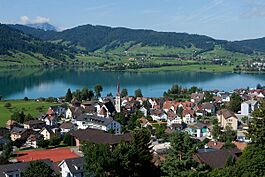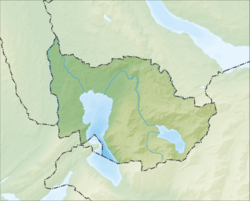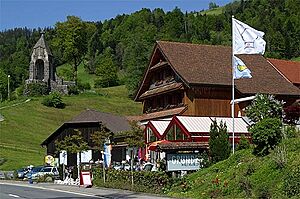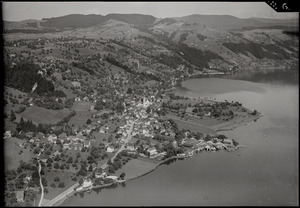Oberägeri facts for kids
Quick facts for kids
Oberägeri
|
||
|---|---|---|
 |
||
|
||
| Country | Switzerland | |
| Canton | Zug | |
| District | n.a. | |
| Area | ||
| • Total | 30.03 km2 (11.59 sq mi) | |
| Elevation | 737 m (2,418 ft) | |
| Population
(Dec 2020 )
|
||
| • Total | 6,382 | |
| • Density | 212.52/km2 (550.43/sq mi) | |
| Postal code |
6315
|
|
| Surrounded by | Einsiedeln (SZ), Feusisberg (SZ), Hütten (ZH), Menzingen, Rothenthurm (SZ), Sattel (SZ), Unterägeri | |
Oberägeri, which was called Ägeri until 1798, is a town (known as a municipality) in the canton of Zug in Switzerland. It's a beautiful place known for its lake and an important historical battle.
Contents
History of Oberägeri
Oberägeri first appeared in old records in 1150 with the name Agregia. Later, in 1538, it was mentioned as Ober Egere.
The first church in this valley was built way back in 876. After the year 1100, the land belonged to the Einsiedeln monastery. The area was greatly shaped by a famous event called the Battle of Morgarten.
The Battle of Morgarten (1315)
The Battle of Morgarten happened on November 15, 1315. It took place near Morgarten, which is now part of Oberägeri, and close to the town of Sattel. This battle started when about 1,500 Swiss foot soldiers, mostly archers, surprised a group of Austrian soldiers. The Austrians were part of the Holy Roman Empire and were led by Duke Leopold I of Austria.
The Swiss soldiers, led by Werner Stauffacher, set up a trap. They blocked the road and waited in ambush at a narrow spot. This spot was between Lake Aegeri and Morgarten Pass, where a small path ran between a steep hillside and a swamp. When the Austrian knights arrived, the Swiss attacked from above. They used rocks, logs, and long weapons called halberds. The Austrian knights had no space to fight back properly and were badly defeated. The Austrian foot soldiers at the back quickly ran away towards the city of Zug. People at the time said the Swiss fighters were very fierce and didn't follow the usual rules of knight battles. This made the Swiss known as tough and respected fighters.
What Happened After the Battle
Just a month after their big victory, in December 1315, the Swiss renewed their promise to work together. This promise was first made in 1291 and is known as the start of the growth of the Old Swiss Confederacy. Over the next forty years, important cities like Lucerne, Zug, Zürich, and Bern joined this group of Swiss states.
The victory at Morgarten gave the Swiss people a lot of freedom. It also gave them about sixty years of peace before the next attack from the Habsburg family. That next attack led to another important battle, the Battle of Sempach in 1386.
The town of Oberägeri as we know it today started to form in the 1400s. Around the year 1500, several small churches and the first government building were constructed in Oberägeri. In 1669, the people of Oberägeri gained the right to choose their own priest.
In 1766, the governments of Oberägeri and Unterägeri (which was then called Wilägeri) had a big disagreement during their local meetings. Because of this, the two towns officially separated in 1798.
In 1838, the city of Zürich stopped collecting money they had been owed from Oberägeri since the Middle Ages. In the same year, the first school building in Oberägeri was built. It took a long time for the second school to be built, which happened in 1956. Water pipes to supply the town were set up in 1890 by a local pub owner.
Geography of Oberägeri
Oberägeri covers an area of about 36.2 square kilometers (14 square miles). A small part of this area, about 0.8%, is covered by buildings. Roads and transportation take up about 2.9% of the land.
A large part of Oberägeri, about one-third (33.8%), is used for farming. Small gardens make up about 2.0% of the area. Forests and other wooded areas cover a big portion, about 37.4% of the municipality. About 17.5% of the land is covered by water, including the beautiful Ägerisee (Lake Aegeri). Finally, about 5.7% of the area is marsh or moorland.
The town is located in a high valley in the eastern part of the pre-Alps. It sits on the northern shores of the Ägerisee, about 724 meters (2,375 feet) above sea level. Oberägeri includes the main village and smaller communities called hamlets. These include Morgarten/Hauptsee and Alosen, which is at a higher elevation of about 897 meters (2,943 feet). There are also many scattered farmhouses throughout the area.
People and Population
Oberägeri has a population of 6,382 people (as of 31 December 2020). About 19.7% of the people living here are from other countries (foreign nationals). Over the last 10 years, the number of people living in Oberägeri has grown by about 14.1%.
Most people in Oberägeri (about 90.2%) speak German. English is the second most common language, spoken by about 2.6% of the population. Dutch is the third most common, spoken by about 1.1% of the people.
Politics and Education
In the 2007 Swiss national election, the most popular political party in Oberägeri was the CVP, which received 33% of the votes. The next most popular parties were the SVP (32.3%), the FDP (18.1%), and the Green Party (12%).
When it comes to education, about 76.9% of the people in Oberägeri between the ages of 25 and 64 have finished either advanced high school education or higher education, like university or a specialized college.
Oberägeri has a low unemployment rate of 1.14%. As of 2005, there were 251 people working in farming and related businesses. There were 355 people working in manufacturing and construction. The largest number of people, 1,049, worked in service industries like shops, hotels, and offices.
Population Over Time
Here's a look at how the population of Oberägeri has changed over the years:
| year | population |
|---|---|
| 1660 | 789 |
| 1743 | 871 |
| 1798 | 1332 |
| 1850 | 1,807 |
| 1900 | 1,891 |
| 1950 | 2,453 |
| 2000 | 4,740 |
See also
 In Spanish: Oberägeri para niños
In Spanish: Oberägeri para niños







